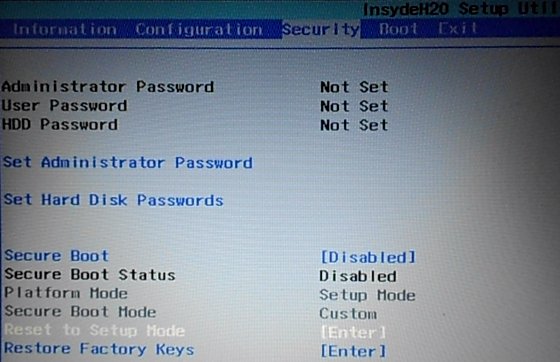
 Next, navigate to the Secure Boot option and turn it on. You may also have an option to disable legacy boot methods, and this is recommended. In each case, choose UEFI or UEFI native. Some devices may offer three choices, like UEFI native, UEFI hybrid (or UEFI + CSM), and Legacy. Many menus present UEFI and Legacy as the choices, others may offer UEFI and BIOS. Navigate the menu and select UEFI as the boot mode. On an HP device, this is often F10 and for a Dell it is F2.
Next, navigate to the Secure Boot option and turn it on. You may also have an option to disable legacy boot methods, and this is recommended. In each case, choose UEFI or UEFI native. Some devices may offer three choices, like UEFI native, UEFI hybrid (or UEFI + CSM), and Legacy. Many menus present UEFI and Legacy as the choices, others may offer UEFI and BIOS. Navigate the menu and select UEFI as the boot mode. On an HP device, this is often F10 and for a Dell it is F2. :max_bytes(150000):strip_icc()/secureboot01-fe7df309b7bd45a3924a99de26db209f.jpg) Boot into the system settings by powering on the system and using the manufacturer’s method for accessing the system settings. Many manufacturers update their device’s UEFI support and update the system settings menu choices with firmware updates, so consider updating to the latest version.
Boot into the system settings by powering on the system and using the manufacturer’s method for accessing the system settings. Many manufacturers update their device’s UEFI support and update the system settings menu choices with firmware updates, so consider updating to the latest version.  First, take note of the make and model of the machine that you are going to prepare. To turn on the necessary system firmware options, you may need to set a system password on some devices. This includes WinPE 4 and higher, so modern Windows boot media can be used. Secure Boot requires Windows 8.0 or higher. Update the firmware if you are in doubt, or if you don’t see the options you expect in the system menu. Secure Boot requires a recent version of UEFI. If an operating system was installed while Secure Boot was disabled, it will not support Secure Boot and a new installation is required. Secure Boot must be enabled before an operating system is installed. When Secure Boot is enabled, the operating system and any other boot media must be compatible with Secure Boot. 1 Secure Boot does not encrypt the storage on your device and does not require a TPM.
First, take note of the make and model of the machine that you are going to prepare. To turn on the necessary system firmware options, you may need to set a system password on some devices. This includes WinPE 4 and higher, so modern Windows boot media can be used. Secure Boot requires Windows 8.0 or higher. Update the firmware if you are in doubt, or if you don’t see the options you expect in the system menu. Secure Boot requires a recent version of UEFI. If an operating system was installed while Secure Boot was disabled, it will not support Secure Boot and a new installation is required. Secure Boot must be enabled before an operating system is installed. When Secure Boot is enabled, the operating system and any other boot media must be compatible with Secure Boot. 1 Secure Boot does not encrypt the storage on your device and does not require a TPM. 
If the signatures are good, the PC boots, and the firmware gives control to the operating system. When the PC starts, the firmware checks the signature of each piece of boot software, including firmware drivers (Option ROMs) and the operating system. It is supported on modern versions of Windows, and many distributions of Linux and variants of BSD. Secure Boot is a security standard developed by members of the PC industry to help make sure that your PC boots using only software that is trusted by the PC manufacturer. The Managed Workstation Service recommends configuring your device to support Secure Boot, though it is not required. This type of hardware restriction protects the operating system from rootkits and other attacks that may not be detected by antivirus software. How to Enable Secure Boot Why configure Secure Boot? Setting Up a Managed Workstation Computer.UW Chief Information Security Officer (CISO).



:max_bytes(150000):strip_icc()/secureboot01-fe7df309b7bd45a3924a99de26db209f.jpg)




 0 kommentar(er)
0 kommentar(er)
